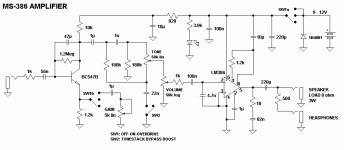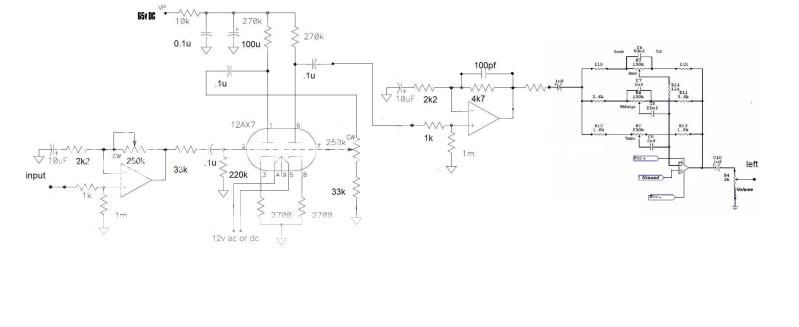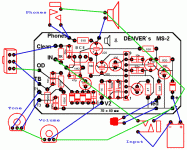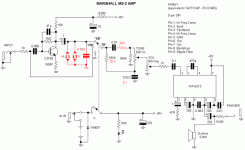Andronico's thread about Marshall's MS-2 microstack amplifier got me wondering how to improve the circuit design. This led me to design a similar amplifier that has some extra features, and on top of that, it uses active components that are probably more easier to find from your local electronics store.
This design has many similar features to MS-2 such as low wattage (about 1W), almost identical frequency response and the same "user interface". However, as an extra this design packs some nice features that the MS-2 lacks: A preamp stage to buffer the signal and to improve SNR plus a variable gain control and tonestack bypass boost.
Teemu K
This design has many similar features to MS-2 such as low wattage (about 1W), almost identical frequency response and the same "user interface". However, as an extra this design packs some nice features that the MS-2 lacks: A preamp stage to buffer the signal and to improve SNR plus a variable gain control and tonestack bypass boost.
Teemu K
Attachments
I tested it but found it too limited for my tastes. Most of the simple stuff that I built I have sooner or later scrapped for parts or used as a base for other projects so currently I have only one LM386-based amp left. ...So, I have no pictures of this one, sorry. Anyway, this design is very basic, mostly boiling down to facts whether you like the amount of gain and distortion tones you get from the single transistor or if you like the tone control’s voicing. If you don’t, there’s not much you can do about it.
Each time when I've built something simple like this (whether its distortion pedals or distorting preamp stages for amps) I have eventually found myself using my digital Zoom multi FX for getting better distortion tones. And since these LM386-based circuits do not exactly qualify as great clean amps they are a bit impractical. They can be very loud (too loud to crank up in apartment) but then they will also distort.
So, in my opinion, there are better LM386-based designs out there - like Massberg Little Rebel (google for schematic and PC board layout) that has a front end similar to Marshall Guvnor pedal and uses bridged output configuration for more power. IMO, that circuit is something more worthwhile to build. If you don’t like the initial tone then you can at least tweak it quite extensively. The only virtue of this one is the simplicity.
Anyway, the end result has a lot to do with some basic issues:
The speakers: Mini speakers are usually too inefficient and sound horrible (boxy sound with too much high frequency content). These amps sound better with those big guitar speakers but then you loose the compact qualities of a “mini” amp and might as well build something else.
Battery: They wear out fast so I have prefered a DC jack instead. Since max. current requirement is still quite high, it - combined with low supply voltage requirement - makes the wall wart quite large. That, once again, puts to consider if battery powered amps are worthwhile. Seriously, if you need battery power then digital amps are a lot better option.
The power amp chip: Today there is no single LM386 chip but a lot of different versions with different power supply ranges and output powers. The datasheet is a bit unclear about the differences and there are also other manufacturers besides National. When you buy something, be sure to check out what you really get. Some LM386 have only half the output power of some others.
That chip also has different architecture and output power than the chip used in Marshall MS-2. Since both designs rely in overdriving the output stage as well you get different tones. Luckily LM386 clips quite nicely.
Each time when I've built something simple like this (whether its distortion pedals or distorting preamp stages for amps) I have eventually found myself using my digital Zoom multi FX for getting better distortion tones. And since these LM386-based circuits do not exactly qualify as great clean amps they are a bit impractical. They can be very loud (too loud to crank up in apartment) but then they will also distort.
So, in my opinion, there are better LM386-based designs out there - like Massberg Little Rebel (google for schematic and PC board layout) that has a front end similar to Marshall Guvnor pedal and uses bridged output configuration for more power. IMO, that circuit is something more worthwhile to build. If you don’t like the initial tone then you can at least tweak it quite extensively. The only virtue of this one is the simplicity.
Anyway, the end result has a lot to do with some basic issues:
The speakers: Mini speakers are usually too inefficient and sound horrible (boxy sound with too much high frequency content). These amps sound better with those big guitar speakers but then you loose the compact qualities of a “mini” amp and might as well build something else.
Battery: They wear out fast so I have prefered a DC jack instead. Since max. current requirement is still quite high, it - combined with low supply voltage requirement - makes the wall wart quite large. That, once again, puts to consider if battery powered amps are worthwhile. Seriously, if you need battery power then digital amps are a lot better option.
The power amp chip: Today there is no single LM386 chip but a lot of different versions with different power supply ranges and output powers. The datasheet is a bit unclear about the differences and there are also other manufacturers besides National. When you buy something, be sure to check out what you really get. Some LM386 have only half the output power of some others.
That chip also has different architecture and output power than the chip used in Marshall MS-2. Since both designs rely in overdriving the output stage as well you get different tones. Luckily LM386 clips quite nicely.
- Status
- This old topic is closed. If you want to reopen this topic, contact a moderator using the "Report Post" button.
- Home
- Live Sound
- Instruments and Amps
- Marshall MS-2 redesigned for LM386



